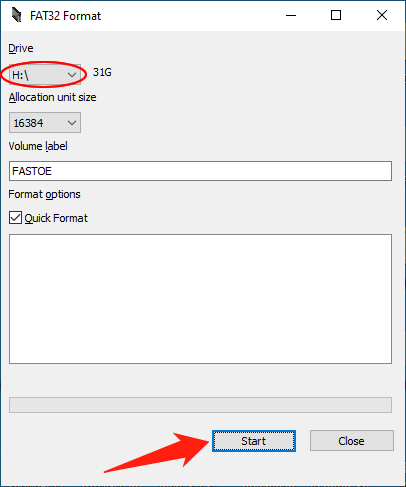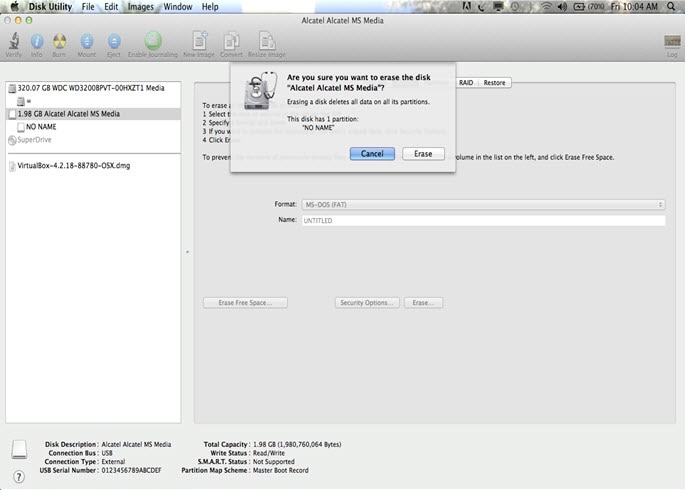Guiformat Fat32 Mac
According to the SD specifications, any SD card larger than 32GB is an SDXC card and has to be formatted with the exFAT filesystem. This means the official SD Formatter tool will always format cards that are 64GB or larger as exFAT.
2, Format usb/sd fat32 using Mac Terminal; 3, Format fat32 with Freecome Hard Drive Formatter or also called FHD Formatter; 1, Best Free MAC FAT32 Formatter - Mac Disk Utility. Mac Disk Utility is probably the best fat32 formatter for you on MAC since you don't have to install any other programs and the simple user interface and easy user manul. There are various free third-party Windows applications that can be used to format SanDisk memory cards in the FAT32 file system for use in devices that do not support the exFAT file system. We recommend the following applications available for download at Softpedia: FAT32format (GUIFormat) HP USB Disk Storage Format Tool.
The Raspberry Pi's bootloader, built into the GPU and non-updateable, only has support for reading from FAT filesystems (both FAT16 and FAT32), and is unable to boot from an exFAT filesystem. So if you want to use NOOBS on a card that is 64GB or larger, you need to reformat it as FAT32 first before copying the NOOBS files to it.
Using Raspberry Pi Imager

Our imaging tool has an option to format an SD card to the correct FAT filesystem. Download the tool from here.

Run the Raspberry Pi Imager application, then from the Choose OS option, select Erase (Format card as FAT32). Now select the SD card you wish to format from the Choose SD Card option, and finally click on Write.
Other Options
Linux and Mac OS
The standard formatting tools built into these operating systems are able to create FAT32 partitions; they might also be labelled as FAT or MS-DOS. Simply delete the existing exFAT partition and create and format a new FAT32 primary partition, before proceeding with the rest of the NOOBS instructions. On a Mac, this means using the command-line diskutil program and choosing the Master Boot Record scheme.
Windows
The standard formatting tools built into Windows are limited, as they only allow partitions up to 32GB to be formatted as FAT32, so to format a 64GB partition as FAT32 you need to use a third-party formatting tool. A simple tool to do this is FAT32 Format which downloads as a single file named guiformat.exe - no installation is necessary.
Run the SD Formatter tool first to ensure that any other partitions on the SD card are deleted. Then run the FAT32 Format (guiformat.exe) tool, ensure you choose the correct drive letter, leave the other options at their default settings, and click 'Start'. After it has finished, you can proceed with the rest of the NOOBS instructions.
If the FAT32 Format tool doesn't work for you, alternative options are MiniTool Partition Wizard Free Edition and EaseUS Partition Master Free which are 'home user' versions of fully featured partition editor tools, and so not as straightforward to use.

According to the SD specifications, any SD card larger than 32GB is an SDXC card and has to be formatted with the exFAT filesystem. This means the official SD Formatter tool will always format cards that are 64GB or larger as exFAT.
The Raspberry Pi's bootloader, built into the GPU and non-updateable, only has support for reading from FAT filesystems (both FAT16 and FAT32), and is unable to boot from an exFAT filesystem. So if you want to use NOOBS on a card that is 64GB or larger, you need to reformat it as FAT32 first before copying the NOOBS files to it.
Using Raspberry Pi Imager
Fat32 Format Tool For Mac
Our imaging tool has an option to format an SD card to the correct FAT filesystem. Download the tool from here.

Run the Raspberry Pi Imager application, then from the Choose OS option, select Erase (Format card as FAT32). Now select the SD card you wish to format from the Choose SD Card option, and finally click on Write.
Other Options
Guiformat Tool
Linux and Mac OS
The standard formatting tools built into these operating systems are able to create FAT32 partitions; they might also be labelled as FAT or MS-DOS. Simply delete the existing exFAT partition and create and format a new FAT32 primary partition, before proceeding with the rest of the NOOBS instructions. On a Mac, this means using the command-line diskutil program and choosing the Master Boot Record scheme.
Windows
The standard formatting tools built into Windows are limited, as they only allow partitions up to 32GB to be formatted as FAT32, so to format a 64GB partition as FAT32 you need to use a third-party formatting tool. A simple tool to do this is FAT32 Format which downloads as a single file named guiformat.exe - no installation is necessary.
Run the SD Formatter tool first to ensure that any other partitions on the SD card are deleted. Then run the FAT32 Format (guiformat.exe) tool, ensure you choose the correct drive letter, leave the other options at their default settings, and click 'Start'. After it has finished, you can proceed with the rest of the NOOBS instructions.
Gui Format Fat32 Mac
If the FAT32 Format tool doesn't work for you, alternative options are MiniTool Partition Wizard Free Edition and EaseUS Partition Master Free which are 'home user' versions of fully featured partition editor tools, and so not as straightforward to use.
